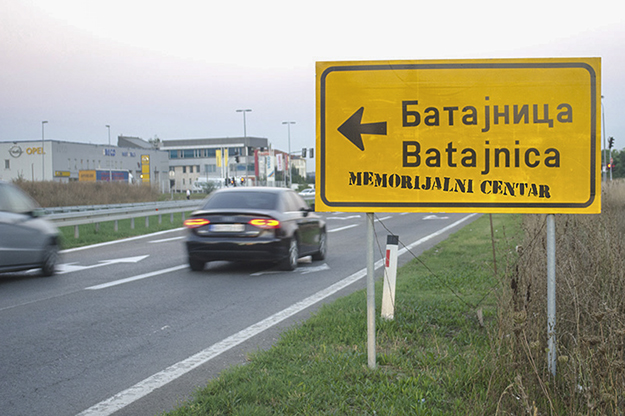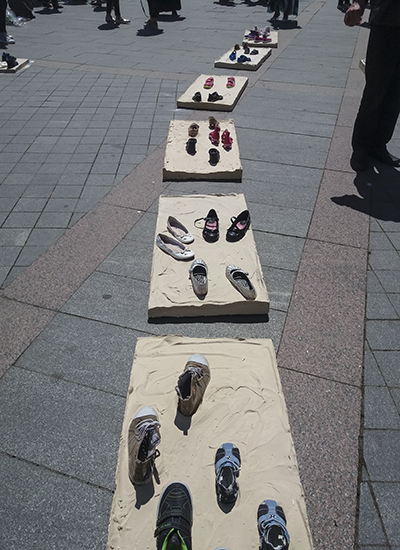Twenty seven years have passed since the start of the wars in the countries emerging from the breakup of Yugoslavia, while 19 years have ended since the last civilian victims of war fell in these territories. According to data from research conducted by the Zagreb based Documenta Center for Dealing With the Past, some 130,000 people died during the wars of the nineties, while 12,000 are still missing. In the last war in the region, in Kosovo, 13,525 people went missing or perished according to data from the Humanitarian Law Center.
While many memorials have been built to commemorate the soldiers that died in these wars, only a handful have been erected for the many civilians killed. However, numerous activist groups in the region have struggled for killed civilians not to be forgotten, often working together, united by not wanting to accept such a reality.
In part thanks to these activists, there are a few marked places of civilian casualties across the region, including in Prijepolje, Vukovar, Srebrenica, Sarajevo, Mokro Polje, Varivode, Gošići, Golubac, Belgrade… However, what preceded almost all of the constructions of these monuments was a battle with the authorities, and battles over commemoration are still ongoing across the region.
State secret
In early April 1999, the freight container of a truck surfaced in the Danube, near the village of Tekija, close to the Serbian border with Romania. It was discovered to be filled with corpses. What happened next was kept as a state secret for over two years, until a working group for Serbia’s Ministry of the Interior published the results of an investigation in May 2001.
The investigation found that the then Interior Minister and head of the Public Security Department, Vlastimir Đorđević, instructed local officials to conceal the bodies from the public and bury them somewhere around the town of Kladovo in eastern Serbia. When it was clear that the operation would fail due to lack of resources, Đorđević arranged for the bodies to be transferred in an operation given the code name ‘Depth Two,’ which he declared a state secret.
The corpses, later revealed to be from a massacre in southern Kosovo, were transferred to the outskirts of Belgrade. They ended up in a small urban community called “13th May” between Zemun and Batajnica, which housed a training center for the Ministry of the Interior’s Special Terrorism Unit.
For almost two years, the inhabitants of Batajnica didn’t know that they lived so close to these secret mass graves, while the training center on the site continues to function to this day.
After the findings of the investigation were released, a number of exhumations began at the center, which until today have uncovered the bodies of 744 Kosovo Albanians, including women and children. For almost two years, the inhabitants of Batajnica didn’t know that they lived so close to these secret mass graves, while the training center on the site continues to function to this day.
In 2011, as part of a guilty verdict for war crimes and crimes against humanity issued by the International Criminal Tribunal for Yugoslavia, Đorđević was found to have played a leading role in attempts to conceal the murder of Kosovo Albanians through clandestine burials in mass graves on land belonging to the Ministry of the Interior, especially at Batajnica. He was sentenced to 18 years in prison.

Humanitarian Law Center began efforts to memorialize the site at Batajnica in the hopes that spreading the truth about past crimes will stop them from recurring. Photo courtesy of the Batajnica Memorial Initiative.
The initiative to mark Batajnica as a place of suffering was set up and led by the Humanitarian Law Center, an organization that has been documenting human rights violations since 1992, but so far the chances are slim that this place will be marked. The goal of the initiative is to establish a memorial center in the place where bodies of those killed were hurled into mass graves.
However, this is not the only place in Serbia that carries memories of civilians who died, with no sign present of something occurring there. Places where camps with Croatian prisoners were located, such as the ones in Sremska Mitrovica, Stajićevo, Begejci, Niš, and Belgrade are also unmarked. There are also no signs to be found in the camps in Šljivovica and Mitrovo Polje that were designed for Bosniaks from Srebrenica and Žepa.
Marko Milosavljević from the Youth Initiative for Human Rights (YIHR), a network of non-governmental organizations from the region that has been functional since 2003 and focuses on the process of society democratization through dealing with the past, told K2.0 that he feels memorial culture is not inclusive. “The state has an obligation to refer to the past in a mindful manner,” he added.
Compassion with the Zec family
On Dec. 8, 1991, wealthy butcher Mihajlo Zec was killed in an attempt to escape from his family home in the Trešnjevka neighborhood of Zagreb. Armed persons had entered his house at around 11 o’clock at night and abducted his wife Marija and daughter Aleksandra, before taking them to the Adolfovac mountain shelter in Sljeme, where they were also killed.
Not long after the police had found the bodies, four members of the Croatian reserve police were arrested. The commander of their unit, Tomislav Marčep was later found guilty for a number of war crimes committed in Croatia during the war, including culpability for the murder of the Zec family. In 2016, Marčep was sentenced to seven years in prison for not preventing the crimes from being committed.
The trial involving the four men arrested was eventually dismissed due to procedural errors, as confessions from the defendants were thrown out due to a lawyer not being present when they were made. Compensation to the two surviving children of the Zec family was eventually paid by the Croatian state in 2004.
Another family now lives in the place where the Zec family used to live but in 2014 YIHR Croatia requested that the Zec family name be given to a park in the city. The project has still not been implemented.
Vesna Teršelič, director of the Documenta Center for Dealing With the Past told K2.0 that the crime against the Zec family was one of the most covered in the Croatian media. “It was a crime known about early on,” she said. “It draws our attention because a child is involved, and compassion is the overwhelming feeling, and with it, shame.”
Another family now lives in the place where the Zec family used to live but in 2014 YIHR Croatia requested that the Zec family name be given to a park in the city. The project has still not been implemented.
“I believe this reflects the situation in Croatia, where only one narrative of the war is present and it is written into the Homeland War Declaration,” Teršelič stated. The Youth Initiative have described this Declaration as a document “not based on truth,” that is “monopolizing and preventing free public speech about the wars of the nineties, and shutting down the space for analysis, research, and discussions based on established facts.”
“As time passes, the more this declaration is used as means for narrowing down the discussion on the events of the 1991-1995 period, and this space has been ever-decreasing,” Teršelič told K2.0.
Temporary memorials
On May 31, 1992, a call was sent out via Prijedor Radio: “Citizens of Serbian nationality, join your army and police in the pursuit of extremists. Other citizens, of Muslim and Croatian nationalities, have to hang white flags on their apartments and houses, and wear white armbands. Otherwise, they will suffer grave consequences.”
Those who went out with white armbands were taken to camps established nearby by the forces under the command of the then president of the Serbian Republic of Bosnia and Herzegovina, convicted war criminal Radovan Karadžić. In a matter of only a couple of months after this declaration, 3,176 Prijedor residents were killed or missing, mainly civilians.
Of those killed in Prijedor during the war, 102 were children. The youngest was Velid Softić, a two-month old child.
Today in the city there are a few monuments honouring Serbian fighters, but not a single one dedicated to the civilian victims of the war, including for the children killed. In 2013, a group of citizens began to commemorate ‘White Armband Day’ on May 31, which saw people walking through the city wearing white armbands to remember those killed in 1992.
The protest has been repeated for each of the next five years, and every year the march ends with the erecting of temporary monuments in the city center in memory of the killed children. They stay there until midnight, before disappearing until White Armband Day next year. Beside the monuments, those who participate in this form of remembrance lay down 102 white roses, each containing the name of one killed child.

Activists in Prijedor hope that the temporary monuments created placed on ‘White Armband Day’ will one day be joined by a permanent memorial to children killed in the war of the 1990s. Photo: Nidzara Ahmetasevic.
In 2014, the year after the first protest, an initiative was established for erecting a permanent monument to all of the children killed in Prijedor, no matter their ethnicity, but this goal has still not been achieved.
Goran Zorić, one of the co-founders of the movement told K2.0 that the initiative started by first gathering signatures, before being put to the local authorities. “In 2014, the initiative was submitted to the City Council, which has a legal deadline of two months to respond to the petition,” Zorić explained. “In our case, the initiative spent a year and a half in a drawer before things started going anywhere.”
Until this day, the City Council has not publicly expressed its attitude towards the initiative. “Last year [2017], we received a response that no one has anything against the monument, but that the City Council will not start changing the city plan, which effectively means that we cannot erect the monument,” Zorić stated. “Actually, the Assembly does everything in its power for the monument not to be erected.”
“My personal feeling is that most citizens would have nothing against this monument, but they are not prepared to say it publicly.”
Goran Zorić, Activist from Prijedor
Earlier this year, the mayor of Prijedor proposed a monument commemorating all the children from Prijedor killed in the twentieth century. However, parents of the children who died in wars of the nineties declared the proposal unacceptable, partly because the monument would not contain the names of the children killed, but also due to the fact that it would not specifically mark what happened during the Bosnian war in the 1990s.
“There have also been suggestions to build a monument in the wider city area, that is, to place it in a village where no one would see it, which is also unacceptable,” Zorić added. “My personal feeling is that most citizens would have nothing against this monument, but they are not prepared to say it publicly.”
Unlike the proposed monument for the killed children, for which a number of permits and permissions are required, the one erected to the fallen fighters of the Army of Republika Srpska, where the names of the fighters are stated and which is located in the very center of Prijedor, was built without a construction permit. “Whenever we asked around about it, we got a response that the legalization process was underway,” Zorić stated.
Truth Commission
The Humanitarian Law Center (HLC), together with a group of other regional organizations, has been advocating for a Regional Truth Commission to be established for years now. This Commission would deal with establishing facts about the wars of the nineties, and initiators hope that its conclusions would open a new space for discussion and memorialization.
The basis for the factual framework would be court verdicts of the Hague Tribunal and domestic judiciaries, as well as findings of civil society organizations regarding the number of victims. Nemanja Stjepanović, from HLC, believes that only on the basis of at least a minimal regional consensus about what has happened in the past, can we build a lasting peace, and this is what would be the goal of this commission. Memorialization is part of that process.
“In order for reconciliation to take place, it is necessary to face the past in a sincere manner, and realize the mistakes done in the name of the different peoples of the region,” Stjepanović told K2.0. “We must renounce the ideas of Greater Serbia, Greater Croatia… everything great, and realize that we are all small, and that the continuation of mutual clashes will lead to the our disappearance from the areas we inhabit.”K
Feature image courtesy of the Jer me se tiče initiative.



